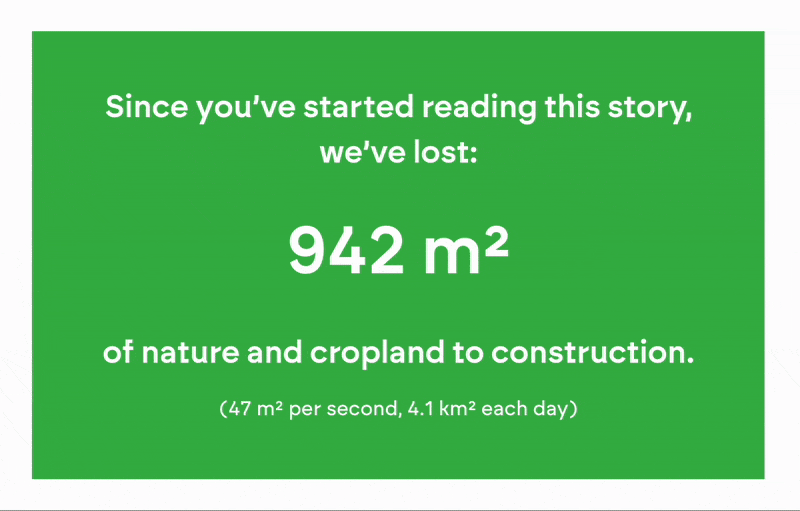On October 1, the Green to Grey project went live. In the first investigation of its kind, 41 journalists and scientists from 11 countries worked together for 10 months to reveal the scale of Europe’s nature and cropland loss.
We found that every year, Europe loses 1,500 km² to construction. Between 2018 and 2023, we lost approximately 9,000km² – an area the size of Cyprus. This is close to 30km² destroyed every week, the equivalent of 600 football pitches every single day. Nature, such as forests, grasslands and wetlands, accounts for the majority of these losses, at about 900km² a year. Agricultural land accounts for 600km² of losses every year, with grave consequences for food security and health.

More than 150,000 constructions, over 70 a day, encroached on protected areas. Some of these constructions may be allowed by an area’s protection status or have received a permit from authorities, while others may be illegally built. These were just some of our shocking headline findings, resulting from almost a year of intensive cross-border collaboration.
We worked with an impressive roster of publishing partners across Europe, and set ourselves some ambitious impact goals. We’re delighted to announce that, one month post-publication, we’ve surpassed our first three goals: to reach at least 1 million readers of the story between all our publications, 25 mentions of the project by other media, and 20 shares from social accounts with at least 10,000 followers.
Our first success was built into the foundation of the collaboration: by bringing all these outlets together, we ended up with 47 publications in 10 languages. The publishing partnership comprised Datadista (Spain), De Standaard (Belgium), Die Zeit (Germany), Facta (Italy), Gazeta Wyborcza (Poland), Le Monde (France), Long Play (Finland), NRK (Norway), Reporters United (Greece), The Black Sea (Turkey), The Guardian (UK), and the Norwegian Institute for Nature Research (NINA), who provided scientific expertise for the project.
This made for a widely accessible project across the continent, producing greater reach than any one of our teams could have alone. One month since we published, we’ve counted more than 3 million readers, viewers and listeners across the project overall.
There have been 57 mentions in other media so far, and we’ve found 21 shares from social media accounts with more than 10,000 followers, meaning we’ve surpassed all our initial reach targets.
There was co-ordinated effort between Arena and partners to tap into a wide network of journalists, scientists and campaigners. We wrote and led a plan to ensure the work reached a diverse collection of people in the journalism, environmental and political fields, and the partner teams focused on translating to their local networks.
But impact is not simply a numbers game. We’ve also been approached by newsrooms in countries that weren’t covered by the original investigation, including Sweden, the Netherlands, and Portugal, to ask if they can use the dataset to produce their own stories. With limited resources, we can’t co-ordinate ongoing stories indefinitely, but we can help teams who want to contribute by helping them navigate our data and methodology.
And individual teams have seen wider impact results, too. Our partners at Le Monde, in France, found a spike in subscriptions tied to their Green to Grey publications. Our partners at The Black Sea, in Turkey, had their highest ever audience traffic. And two partners, Facta in Italy and NRK in Norway – whose original article inspired the project – have already received invitations to present the project at conferences.
Finally, alongside writing a scientific paper on the methodology, now under review, our scientific partners at NINA have developed a citizen science project in the form of an app. The Global Nature Loss app invites anyone to help them track land loss across the world. In this way, our project has already found its next “scale up”.
The story of our project is one of growth through collaboration: from the original Norwegian project, we expanded the project continent-wide; now, the Global Nature Loss project might mean we soon have a better picture of runaway construction worldwide. As a result, people around the world will have a better foundation to act on it.
So, we believe this is just the beginning and that Green to Grey will have a “long tail”. Arena’s previous collaborations show precedent for this: a perfect example being the impact of the Forever project, co-ordinated by Stephane Horel of Le Monde in partnership with Arena.
This impact work has been captured by the Bureau for Investigative Journalism’s impact newsletter The Spark this week, guest edited by our Comms Manager, Eliz Mizon. We’re hopeful that, just a month in, this is only the beginning of Green to Grey’s impact journey.
Watch and share the Green to Grey trailer and the investigation:
